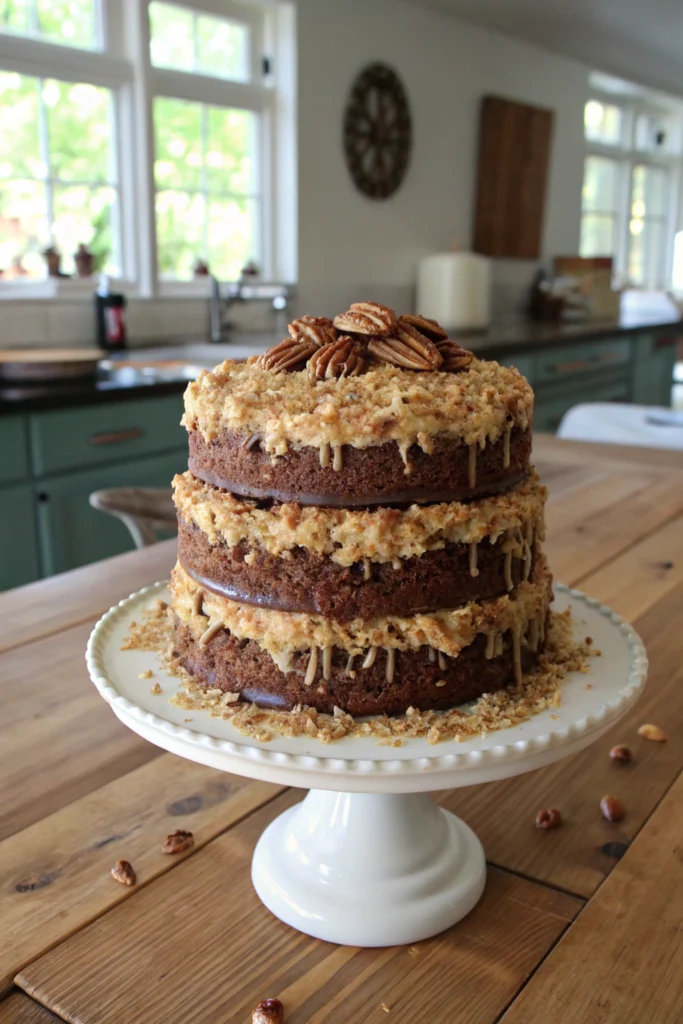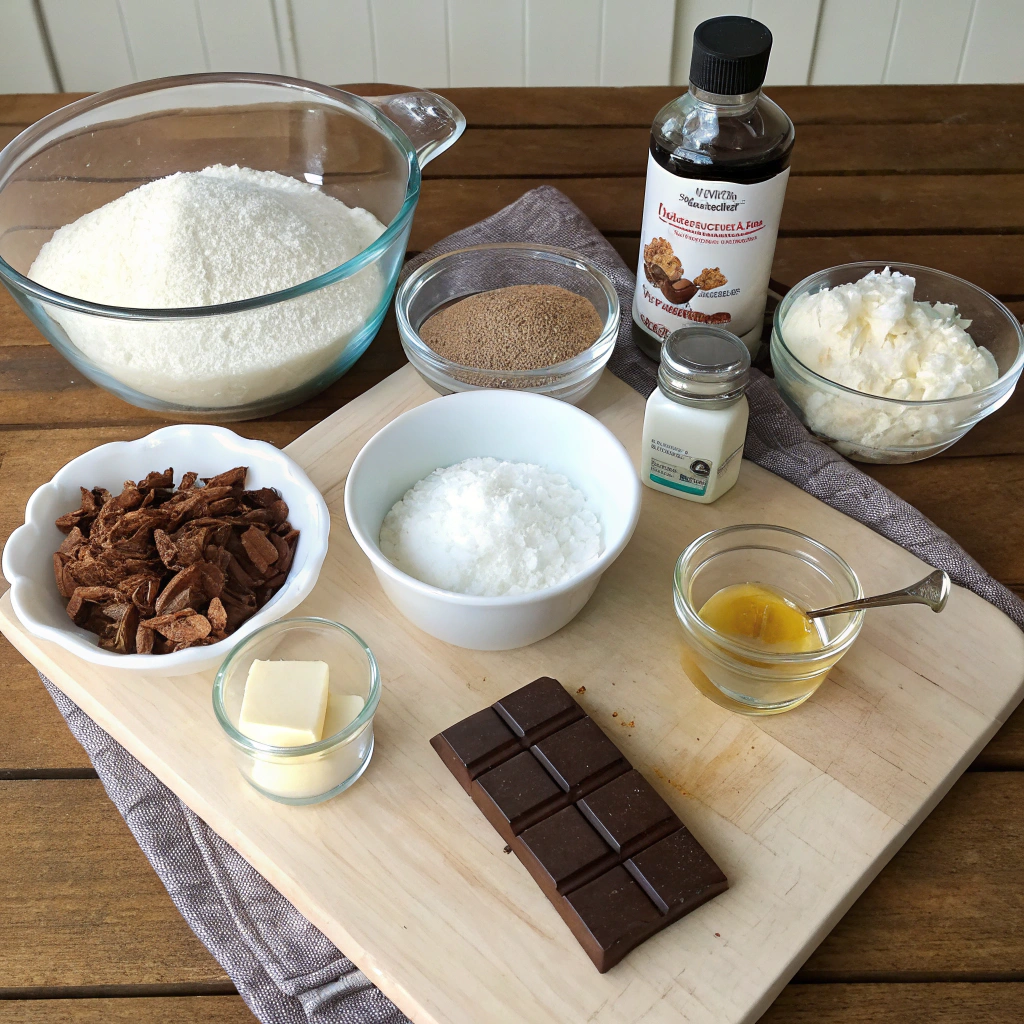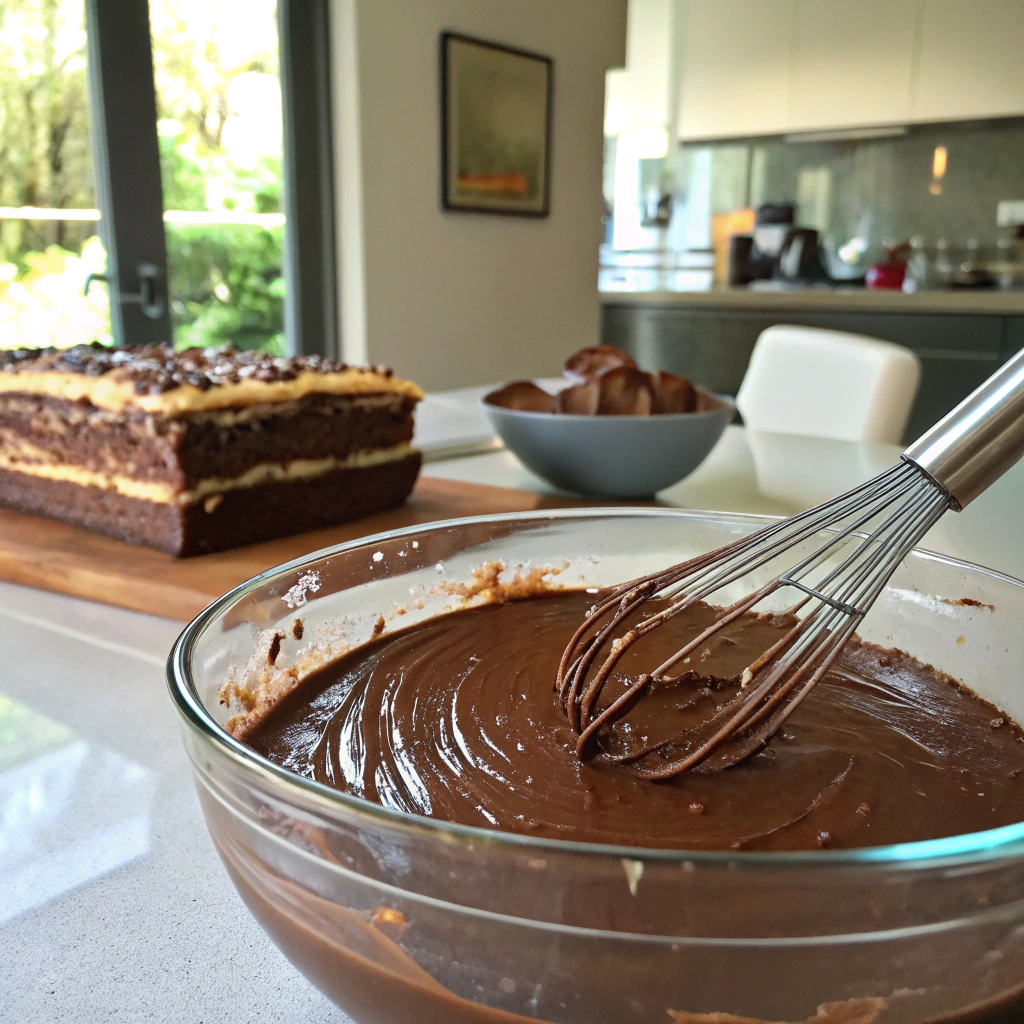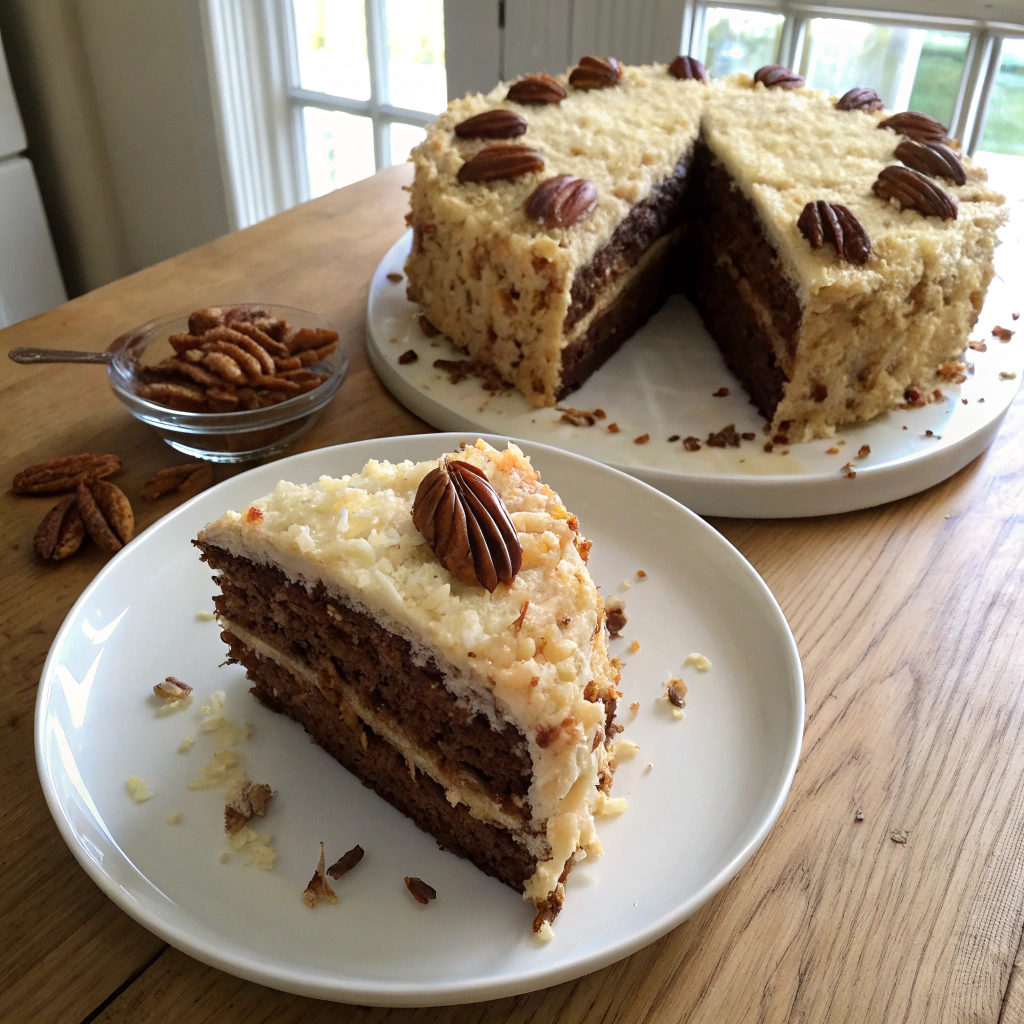Nutritional values
Servings: 12 ServingCalories:586kcalTotal Fat:32gSodium:347mgTotal Carbohydrate:71gDietary Fiber: 3gSugars: 54gProtein:8g


Y'all, I can't tell you how many times I've made this German chocolate cake over the years! It's been my go-to celebration cake since I first stumbled across my grandmother's recipe card, all splattered with cocoa and vanilla stains. Last weekend, while baking it for my daughter's 16th birthday, I realized I've never shared the full story behind this family favorite German chocolate cake recipe.
The funny thing is, every time I bring it to a potluck, someone asks, "Is this really German?" Well, grab your mixing bowls and settle in, because boy, do I have a story for you about this incredibly moist, coconut-pecan topped German chocolate cake masterpiece that's definitely not as German as you might think!
Here's something that'll knock your socks off - German chocolate cake isn't German at all! I remember being so sure it was European when I first started baking it. But nope! The name actually comes from a guy named Samuel German, not the country. It's like finding out Buffalo wings aren't really from buffalos (which I embarrassingly believed until college, by the way).
The German chocolate cake is as American as apple pie, born right here in the USA. What's even funnier is that folks in Germany probably scratch their heads when they hear about it - it's not part of their baking tradition at all!
Back in 1852, Sam German was working at Baker's Chocolate Company when he created something special - a new type of sweet baking chocolate. The company named it "Baker's German's Sweet Chocolate" in his honor. The chocolate was darker than milk chocolate but sweeter than semi-sweet, and it sat there quietly on grocery shelves for over 100 years!
Then, in 1957, everything changed when a Texas homemaker sent her German chocolate cake recipe to a Dallas newspaper. She used German's Sweet Chocolate, and boom! The recipe spread like wildfire across the country. I actually found one of those original newspaper clippings in my great-aunt's recipe box!
Let me tell you, this German chocolate cake took off faster than hot gossip at a church potluck! After that Dallas newspaper printed the recipe, sales of Baker's German's Sweet Chocolate shot up 73% in just one year. General Foods (who owned Baker's back then) started printing the recipe on chocolate bar boxes, and home bakers everywhere went crazy for it.
For another decadent chocolate dessert option, try making easy chocolate mousse recipe - it's silky smooth and foolproof! The timing was perfect - Americans in the 1950s were all about convenience foods and fancy desserts. My grandma told me she remembered everyone bringing this German chocolate cake to neighborhood gatherings. These days, you'll find it in bakeries coast to coast, though if you ask me, nothing beats making this classic German chocolate cake recipe from scratch in your own kitchen!

Let's talk chocolate - it's the star of our show! For a true German chocolate cake, you'll want German's Sweet Chocolate, created by Samuel German back in 1852. I learned this the hard way after using regular baking chocolate once (total fail!).
The traditional choice is Baker's German's Sweet Chocolate, but I've found Ghirardelli's Sweet Ground Chocolate works beautifully too. If you're in a pinch, you can mix semi-sweet chocolate with a tablespoon of sugar for every ounce used for your German chocolate cake. Just avoid Dutch-processed cocoa - it's too mild for this recipe.
I'll be honest - I've tried both ways, and making your own coconut pecan frosting is worth every minute. Store-bought versions often taste artificial and can be overly sweet. When making it from scratch for your German chocolate cake, toast your pecans first (5-7 minutes at 350°F) until they're fragrant. For the coconut, I prefer unsweetened flakes - they let you control the sweetness better.
My grandma's secret was adding a tiny pinch of salt to the coconut pecan frosting, which really brings out the caramel notes. Keep leftover frosting in the fridge for up to a week.
Beyond the specialty items, you'll need some everyday heroes. Make sure your baking soda and powder aren't expired - test them in warm water to see if they bubble actively. Room temperature eggs and butter are non-negotiable (I set mine out the night before) for the perfect German chocolate cake.
For flour, regular all-purpose works great, but cake flour makes an extra tender crumb. Dark brown sugar adds more moisture than light brown, and pure vanilla extract beats imitation every time. Don't forget buttermilk - the real stuff, not the vinegar-milk substitute, makes a huge difference in texture for this German chocolate cake recipe.
Here's a game-changing tip I discovered after years of baking German chocolate cake: cream your butter and sugar for a full 5 minutes - no shortcuts! Start with butter that's cool but bendable, not super soft. I use the paddle attachment on medium speed and scrape the bowl twice during creaming.
When adding eggs for your German chocolate cake, drop them in one at a time, beating for 30 seconds each. For the chocolate mixture, let it cool until it's just warm to touch - too hot and it'll scramble your eggs, too cool and you'll get chocolate chunks. While making your own frosting is recommended, you might want to check out our guide on how to melt chocolate properly to ensure perfect results. Fold in your dry ingredients gently, alternating with buttermilk.

Your oven's personality matters more than you might think when baking German chocolate cake! I always start with an oven thermometer check - most ovens run hot or cold. Preheat for at least 20 minutes before baking, and position your rack in the center.
If you're using dark pans for your German chocolate cake, lower the temperature by 25°F to prevent over-browning. Don't open the oven door for the first 20 minutes - this is when the cake structure sets. For even baking, rotate pans halfway through, but do it quickly! Watch for slight pulling away from pan sides as your done-ness clue.
Patience is key when cooling these delicate German chocolate cake layers. Give them 10 minutes in the pans - any longer and they might get soggy, any shorter and they might break. Run a plastic knife around the edges (metal can scratch your pans). Place cooling racks on top of each pan and flip quickly but confidently.
Remove parchment paper carefully if used. Let layers cool completely - at least an hour - before frosting for your German chocolate cake. For extra insurance, I pop my layers in the fridge for 20 minutes before stacking. Handle layers by sliding cardboard rounds underneath - it's worth the extra step!
Making this iconic coconut pecan frosting for German chocolate cake can be tricky, but I've got you covered! Start with room temperature ingredients - this really makes a difference. In a medium saucepan, whisk together evaporated milk, egg yolks, and sugar until smooth. Add butter and cook over medium heat, stirring constantly.
Don't rush this part when making German chocolate cake frosting! It usually takes about 12 minutes until the mixture thickens and starts to bubble. Remove from heat and stir in your toasted pecans, coconut, and vanilla. I learned the hard way that skipping the toasting step for the coconut pecan frosting is a big mistake - it adds so much flavor! Let the mixture cool completely before spreading on your German chocolate cake layers.
Here's a pro tip: if your German chocolate cake frosting seems too runny, pop it in the fridge for 30 minutes and stir occasionally.
Oh, I've had my share of coconut pecan frosting disasters when making German chocolate cake! Here are some fixes for common problems. If your mixture is grainy, you probably cooked it too quickly - next time, keep the heat medium-low and stir constantly. For lumpy frosting, try straining it while it's still hot.
When the German chocolate cake frosting mixture separates (happened to me last Christmas!), whisk vigorously over low heat. Getting specks of cooked egg in your coconut pecan frosting? Use a double boiler method instead of direct heat. My neighbor taught me to add a pinch of salt to the German chocolate cake frosting to balance the sweetness. Brown bits in your mixture? Those are probably overcooked eggs - keep the temperature steady and don't let it boil. Too thick? Add a splash of warm evaporated milk.
Let's talk about keeping your German chocolate cake frosting fresh! Store it in an airtight container - those glass jars with rubber seals work great. In the fridge, your coconut pecan frosting will stay good for up to a week. I usually make extra and freeze portions in ziplock bags - they last about three months.
Before using stored frosting for your German chocolate cake, let it come to room temperature and give it a good stir. If it's too firm, pop it in the microwave for 10-second bursts, stirring between each. For best results, don't freeze frosted German chocolate cakes - the texture gets weird. I label everything with dates using masking tape.

Traditional German chocolate cake decoration is pretty straightforward - that gorgeous coconut pecan frosting between layers and on top, with the sides left naked. But lately, I've been playing around with some fun twists!
Try covering the sides of your German chocolate cake with a thin layer of chocolate buttercream before adding the coconut pecan frosting on top. Some bakers add chocolate ganache drips, which looks amazing. I've seen beautiful versions with chocolate curls pressed into the sides. During fall, I sometimes add candied pecans around the edge of my German chocolate cake. For summer parties, try decorating with fresh berries - they add great color! Remember, though - this cake's charm comes from its rustic look.
You don't need fancy tools to make this German chocolate cake look spectacular! Toast extra pecans and arrange them around the top edge - it takes five minutes but looks so professional. Coconut chips (not the sweetened shredded kind) make beautiful borders on your German chocolate cake.
I often dust the top edges with cocoa powder using a small mesh strainer. For birthdays, I press chocolate-covered espresso beans into the coconut pecan frosting - kids love them! Sometimes I'll add chocolate curls made with a vegetable peeler and warm chocolate to garnish my German chocolate cake. Fresh mint leaves add a pretty pop of green. My go-to trick: warming the knife in hot water makes cutting clean slices of this cake easier.
Planning ahead saves so much stress when decorating German chocolate cake! Make chocolate decorations up to a month ahead - store them in an airtight container in a cool spot. I create simple chocolate shapes by piping melted chocolate onto parchment paper.
Toast extra pecans and store them in the freezer - they'll stay fresh for months to garnish your German chocolate cake. Chocolate curls can be made ahead and kept in the fridge; just let them warm up before using. During busy seasons, I make candied pecans in big batches to decorate this cake. Create chocolate transfer sheets with cocoa butter designs for special occasions.
Remember to store decorated German chocolate cakes in a cool place, away from direct sunlight or heat sources.
I'd love to see your German chocolate cake! Share a photo in the comments or tag #GermanChocolateLove on Instagram. Each week, I feature reader creations in our newsletter, along with exclusive tips and variations. Try adding toasted pecans between layers or swirling extra chocolate into the frosting. Sign up below for weekly baking inspiration, and don't forget to rate this recipe if you try it. Happy baking, friends!
This beloved American cake features three moist chocolate layers made with German's Sweet Chocolate, filled and topped with a rich coconut-pecan frosting. Perfect for special occasions, this family favorite combines the deep flavor of sweet chocolate with the nutty crunch of toasted pecans and tender coconut flakes.
Servings: 12 ServingCalories:586kcalTotal Fat:32gSodium:347mgTotal Carbohydrate:71gDietary Fiber: 3gSugars: 54gProtein:8g
Storage:
Keep covered at room temperature up to 3 days or refrigerated up to 1 week.
Substitutions:
Can use semi-sweet chocolate + 1 tablespoon sugar per ounce instead of German's Sweet Chocolate.
Serving Suggestion:
Serve slightly chilled with coffee or milk. For special occasions, garnish with additional toasted pecans and chocolate curls.